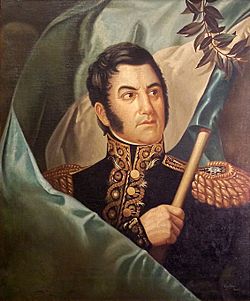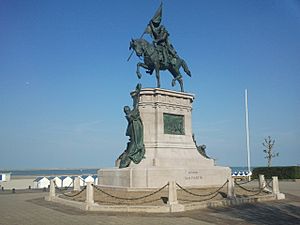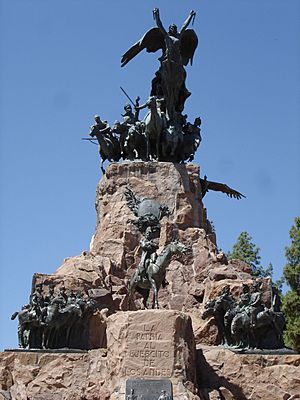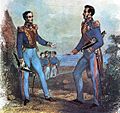José de San Martín facts for kids
Quick facts for kids
José de San Martín
|
|
|---|---|

1820s painting
|
|
| Protector of Peru | |
| In office 28 July 1821 – 20 September 1822 |
|
| Succeeded by | Francisco Xavier de Luna Pizarro |
| Founder of the Freedom of Peru, Founder of the Republic, Protector of Peru and Generalissimo of Armas (ad honorem) |
|
| In office 20 September 1822 – 17 August 1850 (death) |
|
| Governor of Cuyo | |
| In office 10 August 1814 – 24 September 1816 |
|
| Preceded by | Marcos González de Balcarce |
| Succeeded by | Toribio de Luzuriaga |
| Personal details | |
| Born | 25 February 1778 Yapeyú, Corrientes, Viceroyalty of the Río de la Plata (now Argentina) |
| Died | 17 August 1850 (aged 72) Boulogne-sur-Mer, France |
| Political party | Patriot |
| Spouse | María de los Remedios de Escalada y la Quintana |
| Children | María de las Mercedes Tomasa de San Martín y Escalada |
| Profession | Military |
| Signature |  |
| Military service | |
| Allegiance |
|
| Years of service | 1789–1822 |
| Rank | General of Argentina, Commander-in-Chief of the armies of Chile and Peru |
| Commands | Regiment of Mounted Grenadiers, Army of the North, Army of the Andes, Chilean Army |
| Battles/wars | War of the Second Coalition War of the Oranges Peninsular War |
José Francisco de San Martín (25 February 1778 – 17 August 1850) was an important Argentine general. He led the fight for independence from Spain in the southern parts of South America.
Along with Simón Bolívar in the north, San Martín is known as one of the "Liberators" of Spanish South America. He is a national hero in Argentina.
Contents
Early Life and Military Career
José de San Martín was born in Yapeyú, a town in the Corrientes region of Argentina. At that time, Argentina was a Spanish colony. His father was a Spanish official.
San Martín went to a military academy in Madrid, Spain. He joined the army in 1793. He fought for Spain against Portugal and in African colonies. He also fought against Napoleon I's forces when they invaded Spain.
In 1812, he left the Spanish army. He sailed back to Argentina to help the revolutionary forces there. These forces wanted to make Argentina independent from Spain.
Leading the Fight for Freedom
San Martín became a key leader in the fight for independence. He helped train the Army of the Andes. This army made a difficult journey across the Andes mountains to free Chile.
After freeing Chile, San Martín moved his army to Peru. He captured Lima, the capital of Peru, on 9 July 1821. This was a big defeat for the Spanish.
On 28 July 1821, Peru declared its independence. San Martín was chosen as the "Protector" of the new nation. He also founded the National Library of Peru. He gave his own book collection to the library.
San Martín believed that libraries were important for spreading knowledge. He said the new library was "one of the most efficient means to spread our intellectual values."
Later Life and Legacy
After Peru's parliament was formed, San Martín stepped down from his role. In 1824, after his wife, Remedios de Escalada, passed away, he moved to France with his daughter.
He lived the rest of his life in Boulogne-sur-Mer, France. Even though he was almost blind and had health problems, he kept in touch with news from South America. He died on 17 August 1850.
San Martín is remembered as a great hero in Argentina. He is also honored in Chile and Peru. Many cities have statues of him.
There are statues of General San Martín in many places. You can find them in Santiago, Chile, and Lima, Peru. There is also a bust of him in Manila, Philippines.
An equestrian (on horseback) statue of San Martín stands in Boulogne-sur-Mer, France. It was put there in 1909. This statue survived many bombings during both World Wars.

There are also equestrian statues of General San Martín in New York City and Washington D.C. in the United States. These statues were gifts from Argentina.
Many places around the world are named after him. These include a road in Sydney, Australia, and a neighborhood in Bogotá, Colombia. There is even a San Martin road in New Delhi, India.
Images for kids
-
The Battle of Bailén was an important battle where José de San Martín fought.
-
José de San Martín is saved by Juan Bautista Cabral during the battle of San Lorenzo.
-
Meeting of Manuel Belgrano and José de San Martín.
-
Training of the Army of the Andes.
-
Generals José de San Martín (left) and Bernardo O'Higgins (right) crossing the Andes.
-
The Battle of Chacabuco between the Army of the Andes and Spanish forces in 1817.
-
Bernardo O'Higgins, a commander with San Martín, after the victory at Chacabuco.
-
The Chilean Declaration of Independence in 1818.
-
The "Embrace of Maipú" between José de San Martín and Bernardo O'Higgins after the victory at the Battle of Maipú.
-
The Guayaquil Conference between Simón Bolívar and José de San Martín.
-
Mausoleum of San Martín at the Buenos Aires Metropolitan Cathedral.
See also
 In Spanish: José de San Martín para niños
In Spanish: José de San Martín para niños



















